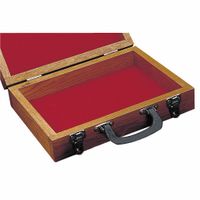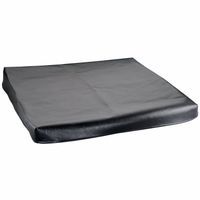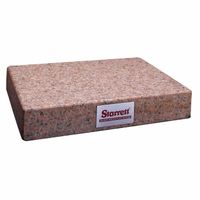Call +(254) 703 030 000 / 751 483 999 / 721 704 777
- Home
- Machining
- Precision Measuring Tools
- Inspection Calibration Tools Equipment
- Surface Plates Stands
.....Read More
Frequently Asked Questions
What are granite surface plates used for?
Granite surface plates are precision tools used primarily in manufacturing and engineering environments for inspection, layout, and measurement tasks. They provide a stable, flat reference surface against which the accuracy of other surfaces can be measured. Made from high-quality granite, these plates are valued for their rigidity, durability, and resistance to wear and corrosion.
The primary use of granite surface plates is in quality control processes. They serve as a baseline for dimensional inspection, allowing for the precise measurement of parts and components. This is crucial in ensuring that manufactured items meet specified tolerances and standards. The flatness of the granite surface plate is critical, as it ensures that measurements are accurate and reliable.
Granite surface plates are also used for layout work, where they provide a stable platform for marking out parts before machining. This helps in achieving precise cuts and shapes, reducing material waste and improving efficiency.
In addition, these plates are employed in the calibration of measuring instruments. Tools like dial indicators, height gauges, and micrometers are often checked against the surface plate to ensure their accuracy. The non-magnetic nature of granite makes it ideal for use with sensitive electronic measuring devices, as it does not interfere with their operation.
Granite surface plates are available in various grades, with higher grades offering greater precision and flatness. They are often equipped with threaded inserts or T-slots to facilitate the attachment of fixtures and accessories, enhancing their versatility in different applications.
Overall, granite surface plates are essential in maintaining the precision and quality of manufactured products, playing a critical role in the fields of metrology, machining, and quality assurance.
How do you maintain a granite surface plate?
To maintain a granite surface plate, follow these steps:
1. **Regular Cleaning**: Use a lint-free cloth or a soft brush to remove dust and debris. For deeper cleaning, use a mild detergent mixed with water. Avoid harsh chemicals that can damage the surface.
2. **Inspection**: Regularly inspect the surface for scratches, chips, or wear. Use a straightedge or a dial indicator to check for flatness deviations.
3. **Calibration**: Periodically calibrate the surface plate to ensure accuracy. This should be done by a professional service using precision instruments.
4. **Protection**: Cover the plate when not in use to protect it from dust and environmental contaminants. Use a dedicated cover or a clean cloth.
5. **Avoid Overloading**: Do not exceed the weight capacity of the plate to prevent warping or damage.
6. **Temperature Control**: Keep the plate in a stable temperature environment to prevent expansion or contraction that can affect accuracy.
7. **Handling**: Use proper lifting techniques or equipment to move the plate. Avoid dragging it across surfaces to prevent damage.
8. **Storage**: Store the plate on a stable, level surface. If not in use for extended periods, consider storing it vertically to prevent sagging.
9. **Avoid Contaminants**: Keep oils, greases, and other contaminants away from the surface. Use dedicated tools and accessories to prevent cross-contamination.
10. **Routine Maintenance**: Establish a routine maintenance schedule based on usage frequency. This includes cleaning, inspection, and calibration.
By following these steps, you can ensure the longevity and accuracy of your granite surface plate.
What are the different grades of granite surface plates?
Granite surface plates are precision tools used for inspection and layout work in manufacturing and engineering. They are classified into different grades based on their flatness tolerances, which determine their suitability for various applications. The primary grades are:
1. **Grade AA (Laboratory Grade):** This is the highest precision grade, used in controlled environments like laboratories. It has the tightest flatness tolerance, making it ideal for high-precision measurements and calibration tasks.
2. **Grade A (Inspection Grade):** Slightly less precise than Grade AA, this grade is used in quality control and inspection areas. It offers a good balance between precision and cost, suitable for most inspection tasks in manufacturing settings.
3. **Grade B (Toolroom Grade):** This grade is used in general workshop environments where high precision is not as critical. It is more affordable and durable, making it suitable for toolroom applications and routine work.
4. **Grade C (Workshop Grade):** The least precise, this grade is used for general workshop tasks where precision is not a primary concern. It is the most economical option and is used for basic layout and assembly work.
Each grade is defined by specific flatness tolerances, which are measured in microinches or micrometers. The choice of grade depends on the precision requirements of the task, the environment in which the plate will be used, and budget considerations.
How do you clean a granite surface plate?
To clean a granite surface plate, follow these steps:
1. **Gather Materials**: You will need a soft, lint-free cloth, a mild detergent or specialized granite cleaner, warm water, and a soft-bristle brush or sponge.
2. **Remove Loose Debris**: Use a dry, lint-free cloth to gently wipe away any dust or loose particles from the surface.
3. **Prepare Cleaning Solution**: Mix a small amount of mild detergent with warm water. Alternatively, use a granite-specific cleaner as per the manufacturer's instructions.
4. **Apply Cleaning Solution**: Dampen the cloth or sponge with the cleaning solution. Ensure it is not soaking wet to avoid excess water on the granite.
5. **Clean the Surface**: Gently wipe the surface plate with the damp cloth or sponge, using circular motions to lift dirt and grime. For stubborn spots, use a soft-bristle brush to gently scrub the area.
6. **Rinse**: Dampen another clean cloth with plain water and wipe the surface to remove any soap or cleaner residue.
7. **Dry the Surface**: Use a dry, lint-free cloth to thoroughly dry the granite surface plate, ensuring no moisture is left behind.
8. **Inspect for Residue**: Check for any remaining streaks or residue. If present, repeat the rinsing and drying steps.
9. **Regular Maintenance**: To maintain accuracy, clean the granite surface plate regularly and avoid placing heavy or abrasive objects on it.
10. **Calibration Check**: Periodically check the surface plate for flatness and accuracy, as cleaning alone does not ensure calibration.
By following these steps, you can effectively clean and maintain a granite surface plate, ensuring its longevity and precision.
Why is granite used for surface plates?
Granite is used for surface plates due to its unique combination of properties that make it ideal for precision measurement and inspection tasks. Firstly, granite is extremely hard and durable, which ensures that the surface plate maintains its flatness and accuracy over time, even with frequent use. This hardness also makes it resistant to scratches and wear, which is crucial for maintaining precision.
Secondly, granite has excellent dimensional stability. It is less affected by temperature changes compared to metals, meaning it expands and contracts minimally with temperature fluctuations. This thermal stability ensures that measurements remain accurate regardless of environmental conditions.
Granite is also non-magnetic, which is important in environments where magnetic interference could affect the accuracy of measurements. This property makes granite surface plates suitable for use with sensitive electronic measuring equipment.
Additionally, granite is naturally resistant to corrosion and does not rust, unlike metal surface plates. This resistance to chemical reactions ensures longevity and reduces maintenance requirements.
The material's homogeneity is another advantage. Granite has a uniform structure without internal voids or inclusions, which contributes to consistent performance across the entire surface of the plate.
Finally, granite surface plates are relatively easy to manufacture to high degrees of flatness and can be lapped to achieve extremely smooth surfaces. This smoothness is essential for precision measurement tasks, as it allows for accurate and repeatable readings.
Overall, the combination of hardness, thermal stability, non-magnetic properties, corrosion resistance, homogeneity, and ease of achieving a smooth, flat surface makes granite an ideal material for surface plates used in precision engineering and manufacturing.
How do you calibrate a granite surface plate?
To calibrate a granite surface plate, follow these steps:
1. **Clean the Surface**: Thoroughly clean the surface plate using a lint-free cloth and a suitable cleaner to remove dust, dirt, and oil.
2. **Stabilize the Environment**: Ensure the calibration environment is stable, with controlled temperature and humidity, as these factors can affect measurements.
3. **Visual Inspection**: Check for any visible damage, such as chips or scratches, which might affect the accuracy.
4. **Select Calibration Tools**: Use a high-precision straightedge, autocollimator, or electronic level, depending on the required accuracy and available equipment.
5. **Grid Layout**: Mark a grid on the surface plate using a non-permanent marker or tape to ensure systematic measurement across the entire surface.
6. **Measure Flatness**:
- **Straightedge Method**: Place the straightedge on the surface and use feeler gauges to measure any gaps.
- **Autocollimator Method**: Set up the autocollimator to measure deviations in flatness by reflecting light off the surface.
- **Electronic Level Method**: Use the electronic level to measure the tilt and flatness across the grid points.
7. **Record Measurements**: Document all measurements and compare them against the plate's tolerance specifications.
8. **Analysis**: Analyze the data to determine if the surface plate is within acceptable flatness tolerances.
9. **Adjustments**: If necessary, lap the surface plate to correct any deviations. This should be done by a professional to ensure precision.
10. **Certification**: Once calibrated, label the surface plate with the calibration date and next due date for recalibration.
11. **Documentation**: Maintain a detailed calibration report for quality control and compliance purposes.
Regular calibration ensures the surface plate maintains its accuracy for precision measurements.
What is the difference between a workshop-grade and a metrology-grade surface plate?
Workshop-grade surface plates are designed for general use in machine shops and manufacturing environments. They are typically made from materials like granite or cast iron and provide a flat reference surface for inspection and layout tasks. These plates are suitable for less critical measurements and are more affordable, making them ideal for everyday use where high precision is not the primary concern. Workshop-grade plates may have a lower degree of flatness and are more tolerant of wear and environmental factors.
Metrology-grade surface plates, on the other hand, are used in precision measurement and calibration laboratories where the highest accuracy is required. These plates are often made from high-quality granite due to its stability, resistance to temperature changes, and minimal wear over time. Metrology-grade plates have a much tighter flatness tolerance, often verified and certified to national or international standards. They are used for calibrating instruments, high-precision measurements, and quality control processes where even the smallest deviations can be critical.
In summary, the main differences lie in the level of precision, material quality, and intended use. Workshop-grade plates are more robust and cost-effective for general applications, while metrology-grade plates offer superior accuracy and stability for high-precision tasks.



